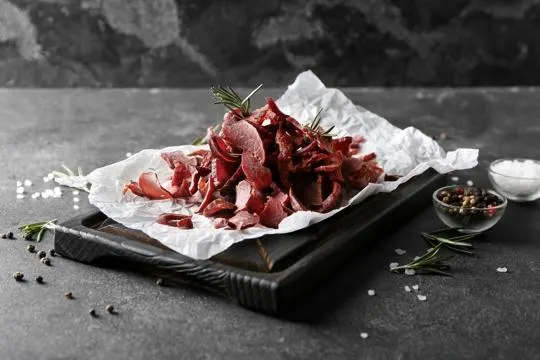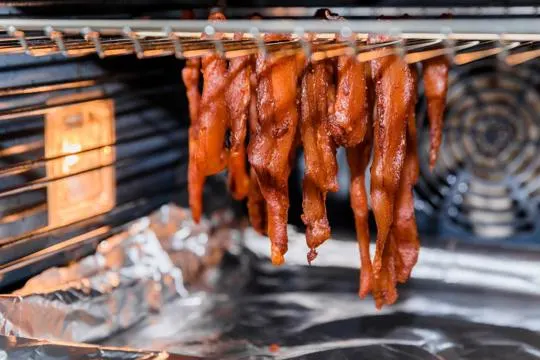Summary of key points
If you’re looking to make homemade jerky, both the oven and dehydrator can get the job done. However, there are some key differences to consider. An oven is generally quicker and more convenient for making small batches of jerky, while a dehydrator may take longer but can make larger quantities at once. Additionally, using an oven allows for more control over temperature and seasoning, while a dehydrator offers a slower, more even drying process that can result in a better texture. Ultimately, it depends on your personal preference and which method fits your needs best. Whichever option you choose, homemade jerky is sure to be a delicious and satisfying snack.
Jerky making is an art form. We’ve all been there—standing in the kitchen, debating if the oven or a dehydrator is the savvy choice for crafting that perfect batch of jerky.
First off, we should lay down some facts. Dehydrators are designed for this job. They circulate air evenly, ensuring all pieces dry at the same rate.
On the flip side, ovens seem convenient. They’re right there in your kitchen, begging to be used.
We’ve tried both. You’d think one method trumps the other, yet each has its quirks.
The dehydrator whispers sweet nothing into each jerky piece, promising uniform dryness. The oven, on the other hand, is like that overeager friend. Sometimes, it’s a little too intense.
In our quest for jerky perfection, we’ve seen it all. The results? A fascinating mix of highs and lows, depending on the method.
Stay tuned. We’re about to deep-dive into our findings.
What is Jerky?

Beef jerky is a beloved snack, with origins going back to ancient civilizations.
To make it, you marinate the meat in spices and seasonings, then slowly dry it.
This preserves the meat and enhances its flavor.
When making jerky at home, you can either use an oven or a dehydrator.
Ovens are easier and more accessible, but they may not provide even heat.
Dehydrators offer precise temperature control, lower temps and even airflow.
Time-wise, dehydrators take longer to dry jerky than ovens.
However, this can result in a more tender texture and better flavor.
Jerky in Oven: How is it Made?

Oven jerky is a popular snack-making technique.
Thinly sliced meat is marinated in flavorful ingredients, then placed on baking racks.
The oven is set at a low temperature, usually 160°F (71°C).
Jerky cooks for several hours until it’s dry enough.
Ovens provide consistent heat for even cooking.
The oven method requires minimal equipment.
Most kitchens have an oven, so no extra expenses.
You control the temperature and time, so you can customize it for personal preference or recipes.
You can make larger batches in the oven.
Ovens have more space than dehydrators, so multiple baking racks can increase production.
Perfect for making jerky in bulk or sharing with others.
Be aware, however, that oven cooking might take longer than dehydrating.
Dehydrators are designed for drying and have stronger air circulation.
If you’re patient, the oven method can still work well.
Jerky in Dehydrator: How is it Made?

Jerky is renowned in the culinary world. It’s a tasty, protein-rich snack.
But how is it made in a dehydrator? Let’s find out.
- Choose your meat. Beef, poultry, venison – the options are plentiful.
- Prepare a marinade with spices, herbs, soy sauce and Worcestershire sauce. Marinate the meat for several hours or overnight.
- Place thin strips of marinated meat on trays in the dehydrator. Low temperatures and gentle airflow remove moisture over time.
- Monitor the process carefully for the desired texture and chewiness.
Patience and precision are important when making jerky in a dehydrator.
The heat and airflow enable thorough dehydration while keeping flavor and tenderness.
Now you know the mesmerizing transformation from raw meat to delicious jerky.
Get ready to make joyous snacks with this knowledge.
Differences Between Making Jerky in Oven and Dehydrator

Making jerky in the oven and a dehydrator may seem similar.
But, there are differences between the two methods.
Knowing these is essential for the desired outcome.
1 – Cooking Method
Cooking Method is essential for jerky’s flavor and quality.
There are two ways to make it – oven or dehydrator.
Each has its own benefits and drawbacks. Which is better?
In an oven, the heat is spread out equally, making sure the jerky is cooked correctly.
It’s convenient since many people have ovens.
However, it needs to be monitored constantly and you have to turn the meat for even drying.
Cooking time is also longer than using a dehydrator.
A dehydrator offers precise temperature control which produces consistent results.
The low temp keeps more nutrients in the meat.
You also don’t need to turn it or watch it as much – the air flow is even for uniform drying.
Some think jerky cooked in a dehydrator isn’t smoky enough.
Others love the convenience of the dehydrator.
2 – Texture and Consistency
Jerky’s texture and consistency can make or break the experience.
How it’s made – oven or dehydrator – has an impact.
Jerky made in an oven is typically drier and tougher.
This is due to the difficulty of controlling heat, which can lead to overcooking.
This results in a chewier jerky that some people like.
Using a dehydrator offers more precise temperature and airflow control.
This results in more consistent drying.
It also helps to preserve the tenderness of the meat, creating a softer jerky.
Additionally, it reduces the risk of spoilage.
It comes down to personal preference.
Some like the robustness of oven-made jerky, and others enjoy the tenderness of dehydrator-made jerky.
3 – Time and Temperature
When it comes to jerky, time and temp are key. You can use an oven or a dehydrator.
Both require keeping a consistent temperature for even drying and for bacteria prevention.
The oven method needs you to set the temp between 150°F and 175°F – this lets the meat dry without cooking it.
Watch it closely to ensure it’s not overcooked or burnt.
But if you opt for a dehydrator, you get more precise control over the temp.
Most of them have adjustable settings and the ideal temp range is 130°F to 160°F, so the meat dries out without becoming too hot.
Time is also important – it’ll take 4-6 hours for your jerky to be ready, but factors like humidity and meat thickness can change this.
Thicker slices take longer. Some people prefer the oven method for its simplicity and accessibility.
But dedicated dehydrators give you better control over temp and airflow, which results in better jerky.
4 – Flavor Development
Flavor development is a must for the best jerky, no matter if you use an oven or a dehydrator.
The cooking method affects the meat’s flavor and creates a yummy experience.
With an oven, the jerky’s flavor is influenced by high heat and extreme dryness.
The oven’s consistent heat keeps the natural flavors in the meat.
Plus, the controlled temp stops it from overcooking.
This method leads to a tasty end product.
Using a dehydrator also boosts flavor.
Its gentle airflow helps keep the meat’s juices.
It works at lower temps for longer, drying the meat without ruining taste and texture.
This slow process increases the jerky’s flavor.
No matter the cooking method, seasonings, marinades, and spices add flavor.
They infuse their tastes into the meat during marination and further add flavor with cooking.
Finding the right spices and marinades can take your jerky’s flavor to new heights.
Factors to Consider When Choosing Between Oven and Dehydrator

Deciding between an oven or a dehydrator to make jerky? Consider these factors:
- Temperature control: ovens have precise settings for better control, while dehydrators provide consistent heat.
- Capacity and size: ovens are larger, while dehydrators are better for smaller batches.
- Drying process: ovens are faster, but dehydrators can be more flavorful.
- Energy efficiency: dehydrators use less power than ovens.
- Hygiene: dehydrators have removable trays that are dishwasher-safe – making cleanup easier.
Similarities Between Making Jerky in Oven and Dehydrator
Making jerky in an oven or dehydrator? They have similarities.
Both use low temperatures and take 4-6 hours.
This slow process preserves the meat and removes moisture, so it’s extra tasty.
Temperature control is key.
Both an oven and a dehydrator offer this.
The jerky is cooked at a low heat to stay fresh and keep flavor.
Marinating is important too. It adds flavor and tenderizes the meat.
An oven lets you make larger batches.
You can dry more jerky at once – less time, less effort.
A dehydrator has the edge though.
It often has more trays than an oven. More batches? No problem.
Plus, better airflow and ventilation means more consistent drying.
Tips for Achieving the Best Jerky
For amazing jerky, pay attention to detail and use the right methods. Here are some tips:
- Choose lean cuts of beef or other meats with no visible fat.
- Flavor it up with a marinade. Try different recipes with spices, herbs and liquids.
- Cut thin slices with a sharp knife or meat slicer.
- Dry at low temperature according to manufacturer instructions.
- Give each piece space on racks/trays for air circulation.
- Store in an airtight container/vacuum-sealed bag to keep freshness.
Follow these tips for amazing homemade jerky. Enjoy every bite.
Conclusion
While making jerky in an oven or dehydrator can be time consuming and, at times, ineffective, the act of creating jerky from scratch can be incredibly rewarding.
Not only do you save money by avoiding buying pre-made jerky products at the store, but you also know exactly what ingredients were used to create each morsel that goes into your mouth.
Ultimately, the method of creating jerky is a personal decision depending on which kind of equipment you have available and how much time and energy you are willing to put into crafting your own snacks.
Though each method has its advantages and disadvantages, it can be said that they both offer successful outcomes when conducted properly.
Keep experimenting with flavorful ingredients and perfecting your technique so that the end result is enjoyable for all.

Leave a comment